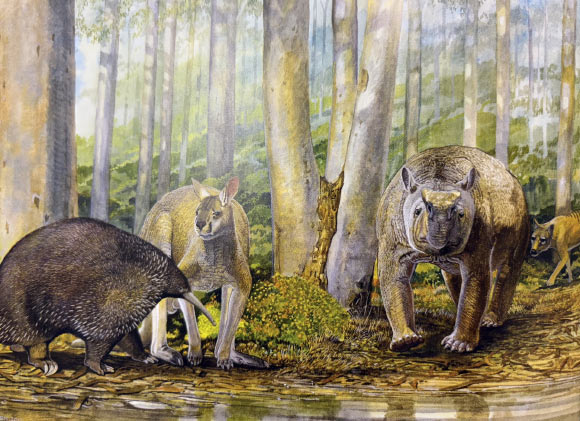In a new study, University of New South Wales Professor Mike Archer and colleagues re-examined the fossilized tibia (lower leg bone) of a now-extinct, giant sthenurine kangaroo. Found in Mammoth Cave in southwestern Australia around the time of the First World War, the bone was later determined to be hard evidence showing that Indigenous Australians hunted megafauna. Professor Archer was involved in the 1980 study that found a distinctive cut in the fossilized bone was evidence of butchery. But he now happily concedes this original finding was wrong.

Megafaunal animals from Mammoth Cave about 50,000 years ago: the giant long-beaked echidna Murrayglossus hacketti, the giant kangaroo Procoptodon browneorum, the giant diprotodontid Zygomaturus trilobus, and the thylacine (Thylacinus cynocephalus). Image credit: Peter Schouten.
“As a scientist, it’s not just my job but my responsibility to update the record when new evidence comes to light,” Professor Archer said.
“Back in 1980, we interpreted the cut as evidence of butchery because that was the best conclusion we could draw with the tools available at the time.”
“Thanks to advances in technology, we can now see that our original interpretation was wrong.”
“When the bones were analyzed from the 1960s onwards, there was much debate about whether or not First Peoples lived compatibly with Australia’s prehistoric megafauna or whether they were the cause of the extinction of these megafaunal animals.”
“Many saw the incision in the bone as being made by humans with tools — and that it finally showed that the extinction of megafauna and arrival of humans about 65,000 years ago was no coincidence.”
“For decades, the Mammoth Cave bone was a ‘smoking gun’ for the idea that Australia’s First Peoples hunted megafauna, but with that evidence now overturned, the debate about what caused the extinction of these giant animals is wide open again, and the role of humans is less clear than ever.”
To re-analyze the same sthenurine leg bone with the incision, Professor Archer and co-authors used high-tech, 3D-scanning to look inside the bone without damaging it.
They also used updated radiometric dating technology to try to work out how old the bone and the cut really were and detailed microscopic analysis of the cut surfaces.
Their analyses revealed the cut was made after the bone had dried out and had developed shrinkage cracks — meaning it was likely already fossilized when the incision occurred.
The paleontologists also analyzed a fossil tooth ‘charm’ given by a Worora Nations man at Mowanjum Mission to Kim Akerman, an archaeologist working with First Nations people in the Kimberley in the 1960s.
The tooth belonged to Zygomaturus trilobus, a type of giant marsupial, distantly related to wombats, that was part of Australia’s Pleistocene megafauna.
Although the tooth was received in the Kimberley, in Northwestern WA, its characteristics and composition were a close match with other fossils from Mammoth Cave in southwestern WA.
“The tooth’s presence in the Kimberley, far from its likely origin in Mammoth Cave, suggests it may have been carried by humans or traded across vast distances,” said Dr. Kenny Travouillon, a researcher at Western Australian Museum.
“This implies a cultural appreciation or symbolic use of fossils long before European science did.”
“You could say that First Peoples may have been the continent’s — and possibly the world’s — first paleontologists.”
The researchers do not completely rule out the possibility that First Peoples hunted Australia’s megafauna.
But without hard evidence, it’s not possible to definitively say Indigenous Australians were responsible for its extinction.
“While these are hypotheses, hard evidence is required before it can be concluded that predation on the now extinct megafaunal species by First Peoples contributed to their extinction particularly given the long history First Nations peoples have had in valuing and sustainably utilizing wildlife in Australia,” Professor Archer said.
“If humans really were responsible for unsustainably hunting Australia’s megafauna, we’d expect to find a lot more evidence of hunting or butchering in the fossil record. Instead, all we ever had as hard evidence was this one bone — and now we have strong evidence that the cut wasn’t made while the animal was alive.”
So if humans weren’t solely responsible for the demise of Australia’s ancient megafauna, what may have caused it?
The researchers cite evidence that many megafauna species vanished long before humans arrived while others co-existed with humans for thousands of years, but their disappearance often coincides with periods of significant climate change.
“What we can conclude is that the first people in Australia who demonstrated a keen interest in and collected fossils were First Peoples, probably thousands of years before Europeans set foot on that continent,” the researchers said.
Their paper was published in the journal Royal Society Open Science.
_____
Michael Archer et al. 2025. Australia’s First Peoples: hunters of extinct megafauna or Australia’s first fossil collectors. R. Soc. Open Sci 12 (10): 250078; doi: 10.1098/rsos.250078







